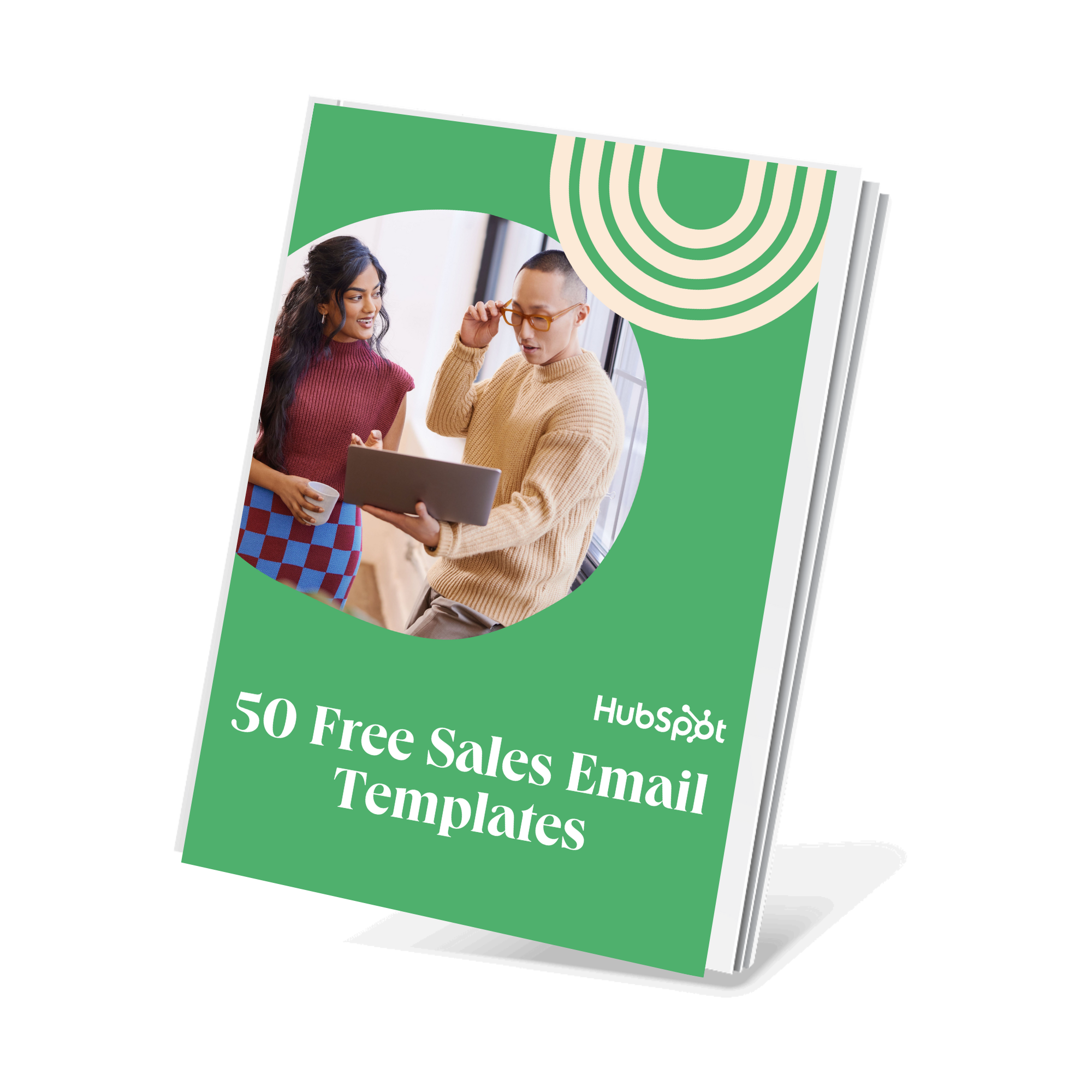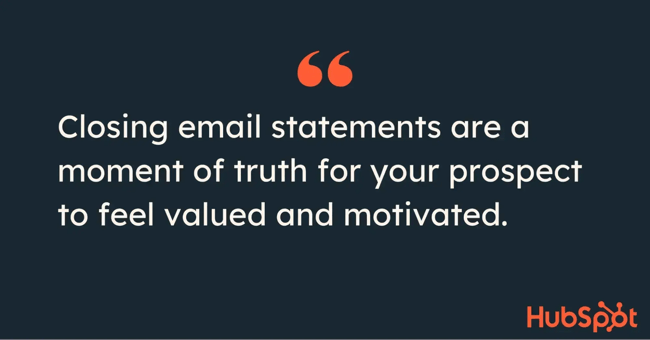As a B2B salesperson for companies like IBM and Open Text, I’ve had to work hard to earn every meeting, especially in industries where inboxes are overflowing and priorities shift daily. I used to obsess over subject lines and intros, but once I learned how to end a sales email, my reply rates took off.
A powerful closing statement doesn’t just tie your message together — it gives your prospect a reason to take action now. Over time, I developed a system for ending my sales emails with confidence, clarity, and results.
Whether you’re trying to secure a meeting, prompt a reply, or push a deal across the finish line, your closing email statement is your moment of truth. Let’s make sure you’re getting it right.
Read on to hear my tactics for ending a sales email, with my top closing statement templates.
Table of Contents
- Why Email Closing Statements Matter
- Best Practices for Ending Your Email
- How to Close a Sales Email
- 6 Closing Email Statements to End Your Email [Templates]

50 Free Sales Email Templates
Save time, find new ways to reach out to prospects, and send emails that actually convert.
- First-Touch Emails
- Follow-Up Emails
- Break-Up Emails
- ChatGPT Email Prompts
Download Free
All fields are required.

You're all set!
Click this link to access this resource at any time.
Why Email Closing Statements Matter
When I wrote sales email calls-to-action (CTAs), I learned that weak closing statements like “Let me know if you have any questions” produced poor outcomes. Aggressive, generic offers were just as fruitless, especially when the prospect hadn’t already confirmed their interest in what I was offering. (In fact, they were almost as poor as weak openings.)
When well written, email closing statements increase the likelihood that a prospect will respond. A clear question or CTA starts a dialogue and clarifies the next steps the recipient should take.

Closing email statements are a moment of truth for your prospect to feel valued and motivated. So, let’s dig into some best practices for how to do it.
Best Practices for Ending Your Email
Here are some takeaways you can use to craft compelling sales email closing statements.
1. Be clear and concise about next steps.
Calls-to-action shouldn’t be up to interpretation. The closing statement should be brief and make it easy for your customer to respond to your offer by suggesting a short phone call at your client’s earliest convenience.

I know it can be hard, but resist the temptation to stack multiple offers and pick just one instead. Invite the customer to attend a webinar, demo your product, or book a call. The more questions you ask, , according to Belkins. You can leverage the first offer acceptance into more yeses down the road.
2. Create a sense of urgency.
Limit the timeframe within which your customer must act on your offer, or use scarcity as an incentive for the prospect to act. I like to give them just enough time to address other urgent items on their calendar.
3. Show your value proposition.
I’ll never forget what a sales trainer named Marty Nuckles once told me: Every prospect or customer’s favorite radio station is WIIFM: What’s In It For Me.
Your closing statement should clarify what they stand to gain professionally from your offer, or at least what their company stands to gain by accepting your offer and buying your products or services. Use “you” to help the customer picture themselves with your solution. I recommend using clear, actionable language like:
- What if you could keep more employees from burning out?
- Imagine being able to catch fraudulent orders as soon as they come in.
- I’d love to share how you can create a more personalized customer experience.
4. Share social proof.
Case studies and testimonials are a great way to end your email and ease any concerns your prospect or customer might have that taking you up on your offer is risky or won’t deliver the rewards you claim.
I’ve found that including a short customer story or a stat in my closing statement builds trust and credibility. For instance, “One of our clients in your industry saw a 30% boost in productivity after switching to our tool. Interested in seeing the case study?” Social proof at the end of an email reassures prospects that I can back up my claims.

5. Personalize the offer to the client.
I can’t count how many times a prospect has replied to an email that referenced a specific challenge or a recent company milestone. Personalization isn’t just about dropping their name — it’s about showing you’ve listened and you understand their needs.
Don’t take my word for it: Our data shows that personalized CTAs perform 202% better than generic CTAs.
To personalize your closing, take what you know about the prospect — their industry, goals, or struggles — and offer a solution. For example, if I know someone’s struggling with onboarding, I’ll close with, “Would you be open to a quick call to see how our platform can cut your onboarding time by 30%?”
6. Ask a question in your closing.
Asking a question in the closing can prompt the user to say “yes.” It can also prompt them to reply with an objection, but that can also start a conversation. There are four types of questions you can ask in a sales email closing:
1. An interest CTA attempts to gauge a prospect’s interest in a topic or solution. Gong data found that interest-based CTAs were the most effective in earning a reply.

Examples:
- Does this sound interesting to you?
- Would you like to discuss [solution] for your team?
2. An open-ended CTA asks an open-ended question to draw the recipient into a dialogue.
Examples:
- How are you currently addressing this challenge?
- Would you be open to a 15-minute call to discuss this?
3. A specific CTA attempts to simplify the cognitive load by asking for a specific action and/or time.
Examples:
- Are you free for a call on Tuesday at 4 PM?
- Can I set up a demo account for you?
4. A value-based CTA gives a specific offer or lead magnet as the next step in the conversation. This is typically exclusive access to a free template, content, or service that’s specific to that person’s industry, role, or challenges.
Examples:
- Would you like early access to our data report?
- Would you be interested in benchmarking your performance against your competitors?
7. Use technology to simplify the process.
Did you know it’s possible to both personalize your outreach and automate it to save time? Here are a few ways I’ve improved my reply rates using :
- to find the best-performing one.
- so I could hyper-personalize my emails.
- Put follow-ups on autopilot with .
- Created a library of to save time.
- Used a to avoid back-and-forth and time zone woes.
My approach is still personalized and intentional, even when using AI — these tools simply give me more information that lets me personalize my closings and schedule calls faster.
8. Leverage a strong, clear email signature.
Make it easy for your prospect to both identify and contact you with a clear email signature that gives them all the information they need. You can use 51吃瓜’s to build a professional email signature with images compressed to avoid spam filters.

50 Free Sales Email Templates
Save time, find new ways to reach out to prospects, and send emails that actually convert.
- First-Touch Emails
- Follow-Up Emails
- Break-Up Emails
- ChatGPT Email Prompts
Download Free
All fields are required.

You're all set!
Click this link to access this resource at any time.
How to Close a Sales Email
In my experience, the most effective email closings follow a simple structure.
1. Summarize the context and value proposition.
Mention the reason for contacting them again and reinforce the key benefit or solution you’re offering. Summarize how your product or service addresses the recipient’s specific pain point or goal. Tailor this final pitch to their context, showing you understand their business or challenges to build trust.
2. Make a value-based offer.
Rather than just asking for a call, consider offering something helpful, like a case study, resource, or quick audit. This shows you’re focused on helping, not just selling. Example: “Happy to send over a quick checklist that’s helped similar teams reduce errors.”
3. Add a subtle sense of urgency (if appropriate).
Find a way to encourage timely action without sounding too pushy. You can mention limited availability, a deadline for a special offer, or suggest that calendars fill up quickly. For example: “I have a few openings this week if you’d like to chat — happy to hold a spot.”
4. Focus on a single, clear call-to-action — don’t bury your ask.
Guide the reader toward the next step you want them to take. Whether it’s booking a demo, replying to the email, or downloading a resource, make the CTA specific, simple, and low-friction. Avoid vague endings like “let me know what you think.” Instead, write something like “Are you available for a quick 15-minute call next Tuesday or Wednesday?”
5. Keep it friendly — but not too friendly.
Close your email with a polite, approachable sign-off. Use a warm yet professional sign-off like “Best regards,” “Looking forward to hearing from you,” or “All the best.” This final impression should match the tone of the rest of your email and leave the door open for further conversation.
6 Closing Statements to End Your Email [Templates]
Here are some examples of sales email closing statements you can emulate with your next campaign and why they are effective.
|
Closing Statement Example |
Why It Works |
|
“Would you be interested in meeting a client who’s faced similar challenges?” |
Personalized, value-driven, includes social proof, and a clear CTA tied to an event. |
|
“I’d love to walk you through a few of my favorite features. Can we set up a quick call this week?” |
Timely, relevant, helpful — not just pushing a sale. |
|
“[Industry] execs often tell me their teams struggle to [common challenge]. Sound familiar? Care to meet to discuss?” |
Industry-aware, empathic, and makes it easy to say yes. |
|
“Now that you’re through year-end reporting, I’d love to hear about your goals for this year.” |
Acknowledges timing, shows understanding, and opens the door to deeper conversation. |
|
“Given your concerns around [objection], this could help clarify the decision.” |
Reframes the objection, invites discussion. |
|
“Can you tell me what best describes your interest?” |
Opens multiple paths for the conversation to continue. |
Closing Statement Example 1: Event Invitation
“Maria, remember our chat about your company’s supply chain bottlenecks? Our client, Steve Jacobs from XYZ Widgets, will share how we helped solve a similar challenge at TransportCon next month. You can use promo code EZBuy2025 for complimentary registration. Would you be interested in meeting Steve after his talk?”
What I like: This closing statement is effective because it’s personalized, value-driven, and includes a clear CTA tied to an event. It also:
- Clearly states a value statement that the prospect would identify with.
- Offers social proof of the value of the proposed services.
- At the beginning of the email, the salesperson refers to a conversation they had earlier in the year, showing context and attention to detail.
Closing Statement Example 2: Product Walkthrough
“Bill, thanks for starting a trial of our HR application for banking. I’d love to walk you through a few of my favorite features for streamlining compliance and simplifying onboarding.
Can we set up a quick call this week? Feel free to grab time via my calendar link below.
[CTA] Schedule your meetup”
What I like: This is an effective closing statement because it’s timely, relevant, and helpful, not pushing a sale. The meeting would be a good use of the prospect’s time by addressing any difficulties the prospect may be having with the trial, and learning about industry best practices should tempt the user if they are a qualified opportunity.
Closing Statement Example 3: Sound familiar?
“Healthcare CISOs and CTOs often tell me their teams struggle to identify and close data security vulnerabilities due to tight resources. Sound familiar? I can share how other orgs are tackling this without disruption.
Can we meet for 30 minutes next week? Here’s my calendar link.”
What I like: This closing statement demonstrates that the salesperson is connected with healthcare industry executives and requests a meeting while leaving the agenda open to what matters most to the prospect. It indicates that the call would be a good use of the prospect’s time and would provide insights about what other organizations are doing to safeguard their data.
Closing Statement Example 4: I’d love to hear about your goals
“Peter, I know you have been busy wrapping up financial reporting. When you have time, I’d love to hear about your strategic goals for this year and discuss how my firm and I could help you reach them.
Is there a day and time that would work for a 15-minute chat next week?”
What I like: This closing statement is brief and acknowledges that the CFO recipient has been unreachable due to other business priorities. The recipient wouldn’t feel guilty for not being responsive during their year-end activities.
They would appreciate the opportunity to engage with someone interested in helping them meet their business goals, who isn’t just pitching products or services. The chat would likely be to schedule a more substantive meeting and not to try and close a deal when the decision maker is just “coming up for air.”
Closing Statement Example 5: This could help clarify the decision
“Jane, let’s set a time next week to discuss the costs associated with moving forward with my proposal versus those related to maintaining the status quo. Given your concerns around risk, this could help clarify the decision. I’m confident you’ll see the upside of a proactive move.”
What I like: This closing statement uses a known objection to justify investing in a solution. One of the biggest sales obstacles wasn’t convincing customers to choose my solution over a competitor’s, but persuading them to change their current situation.
Closing Statement Example 6: What do you want to talk about?
“Kristi, thanks for attending our recent webinar. Can you tell me what best describes your interest?
- Planning a project.
- Exploring tools for the future.
- Simply gathering insights for now.
Would you be interested in connecting next week to chat further about the webinar topic or other business challenges you’re facing?”
What I like: As a sales rep, I often followed up with conference attendees who visited my booth or attended a webinar. When I limited the email to only the event’s topic, my response rate tended to be low. But when my email opened up the discussion to what the email recipient cared about most, it increased response rates dramatically and helped me uncover opportunities I would never have had otherwise.
Want more inspiration? Grab these I’ve used to build pipelines and close deals.
Write closing statements that spark dialogue.
I find my best sales email closing statements clearly state what I wanted the recipient to do next and how they would benefit by meeting with me to discuss their needs and goals.
After investing time and energy in writing personalized messages, prospect replies were my best way of measuring whether my emails were connecting with customers or if I needed to go back to the drawing board.
Rather than pushing for an immediate sale, the best email closings invite conversation, feedback, or questions, which helps build a relationship and keeps the door open for future engagement.
Editor’s note: This post was originally published in July 2024 and has been updated for comprehensiveness.

50 Free Sales Email Templates
Save time, find new ways to reach out to prospects, and send emails that actually convert.
- First-Touch Emails
- Follow-Up Emails
- Break-Up Emails
- ChatGPT Email Prompts
Download Free
All fields are required.

You're all set!
Click this link to access this resource at any time.
Sales Email Mistakes




